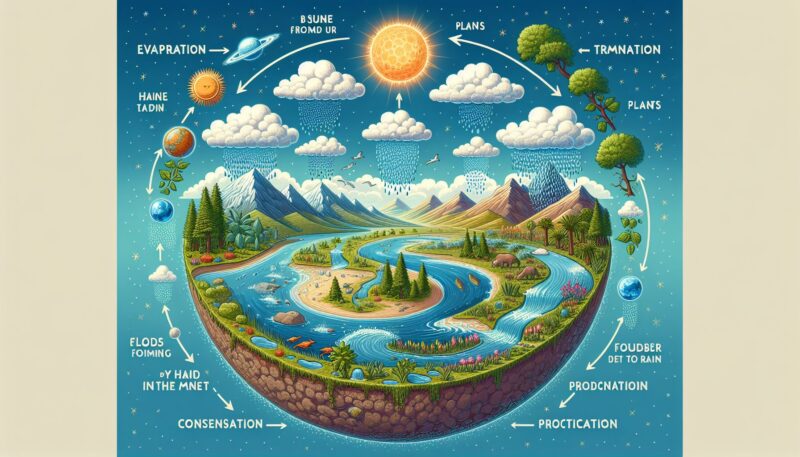Water is life. It is the essential component of our ecosystem, driving all aspects of our natural environment. At the heart of this dynamic system is the hydrologic cycle, also known as the water cycle. It’s a continuous process that describes how water moves above, on, and below the surface of the Earth. This cycle plays a critical role in Earth’s climate, weather patterns, and the sustenance of all life forms.
Understanding the Hydrologic Cycle
The hydrologic cycle is a complex system that involves various processes including precipitation, evaporation, transpiration, condensation, infiltration, percolation, runoff, and more.
Precipitation
Precipitation is the process by which water in its various forms fall from the atmosphere to the ground. This includes rain, snow, sleet, and hail. Precipitation is the primary mechanism by which water in the atmosphere is delivered to Earth.
Evaporation
Evaporation is the transformation of water from liquid to gas. This process occurs when water from the oceans, rivers, lakes, and even soil heats up and vaporizes. It is the main pathway by which water enters the atmosphere.
Transpiration
Transpiration is similar to evaporation but it specifically refers to the water lost from plants as vapor. Plants absorb water from the soil through their roots and then expel some of it as vapor through small pores in their leaves.
Condensation
Condensation is the process by which water vapor in the air is changed into liquid water. Condensation is crucial to the formation of clouds, which eventually lead to precipitation.
Infiltration and Percolation
Infiltration is how water on the ground surface enters the soil. Subsequently, percolation is the downward movement of water through soil and rock layers.
Runoff
Runoff occurs when there is excess water on the ground that can’t be absorbed. This water flows over the land and collects in rivers, lakes, and oceans. Human activities can significantly alter natural runoff patterns and intensity.
Streamflow and Baseflow
Streamflow is the flow of water in streams and rivers. It’s a mixture of runoff and baseflow, which is the portion of the groundwater that flows into rivers.
Groundwater and Aquifers
Groundwater is the water that moves and is stored below Earth’s surface. An aquifer is an underground layer of water-bearing permeable rock or unconsolidated materials from which groundwater can be extracted using a water well.
Recharge and Discharge
Recharge is the process where water is added to an aquifer, typically from the surface or from precipitation. Discharge is where water is removed from an aquifer, such as when wells are pumped or when groundwater flows into rivers or the ocean.
The Global Hydrosphere
The hydrosphere encompasses all the water found on, under, and above the surface of the planet. This includes water in liquid and frozen forms in groundwater, oceans, lakes, glaciers, and the atmosphere.
The Oceans
Oceans are the largest bodies of water on Earth and are integral to the hydrologic cycle. They are the main source of atmospheric water vapor and absorb the largest amount of Earth’s heat, influencing weather and climate patterns.
Lakes and Reservoirs
Lakes are naturally occurring bodies of water or can be man-made reservoirs. They play a crucial role in storing freshwater and acting as a buffer during floods.
Rivers and Streams
Rivers and streams are essential for transporting water from the land to the ocean. They also provide habitats for wildlife and are used for human activities like agriculture, drinking water, and industry.
Glaciers and Icebergs
Glaciers and icebergs are large masses of freshwater ice. They store a significant amount of the Earth’s freshwater and release it slowly as they melt, contributing to sea level rise.
Wetlands, Estuaries, and Permafrost
Wetlands are areas of land that are saturated with water for long periods. Estuaries are coastal wetlands where rivers meet the sea. Permafrost is permanently frozen ground in polar regions. These all play unique roles in the hydrologic cycle, particularly in supporting biodiversity and affecting global climate patterns.
Human Impact on the Hydrologic Cycle
Human activities are profoundly affecting the hydrologic cycle. Deforestation, urbanization, and climate change are altering precipitation patterns, increasing evaporation rates, and changing the amount of water that infiltrates the ground.
Water Pollution
Water pollution from agriculture, industrial discharges, and poor waste management is a significant threat to water quality. Pollutants such as heavy metals, pathogens, and microplastics contaminate water sources making them unsafe for humans and wildlife.
Water Scarcity and Stress
Water scarcity and water stress are becoming increasingly common as demand for freshwater resources grows. Overuse of groundwater for agricultural and urban needs is depleting aquifers faster than they can be recharged.
Solutions and Sustainable Water Management
To ensure the health of the hydrologic cycle and water availability for future generations, sustainable water management practices must be adopted.
Water Treatment and Conservation Technologies
Technologies for water treatment like reverse osmosis, UV irradiation, and various filtration methods are crucial for providing safe drinking water. Water conservation techniques such as rainwater harvesting and greywater reuse can significantly reduce water wastage.
Protecting Water Resources
Protecting watersheds, enforcing strict pollution controls, and restoring wetlands are necessary to maintain the integrity of water resources. Additionally, water diplomacy and water conflict resolution are becoming crucial for managing transboundary water sources.
Conclusion
The hydrologic cycle is a natural marvel that sustains life on our planet. However, it is vulnerable to human-induced changes. By understanding its components and their interactions, we can take effective measures to protect this vital system and ensure a sustainable future for all life on Earth.
